Bangkok Street Kids
We head out onto Bangkok’s streets to discover a forgotten generation. Photos by Chardjakaj Waikawee
Despite recent talk of free WiFi and iPads for all school children, is life really that simple for young people living in Bangkok? Sure your younger brothers and sisters might have all the trappings of modern life from their iPhone 4 to their designer handbag, but what about the kids who don’t get to hang in the high end malls, who in fact don’t even have a roof over their heads?
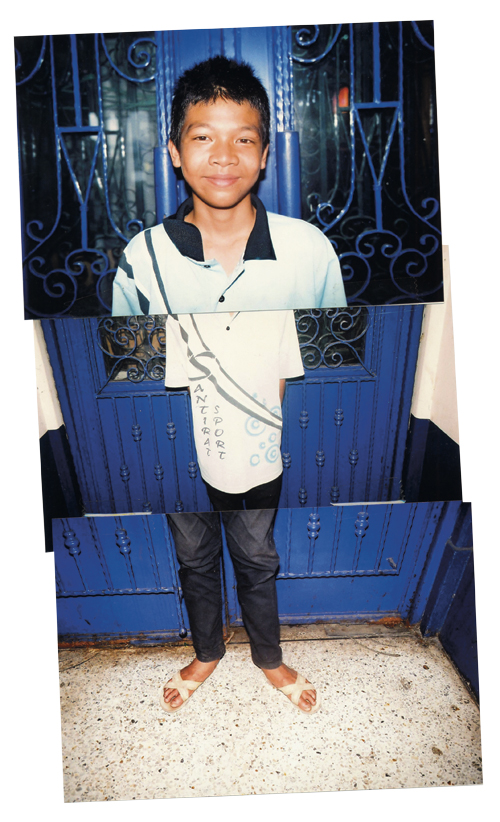
Gott (14), found sleeping on the floor of Hua lamphong terminus wants to be a soldier when he grows up.
“School’s boring. I’d rather play FIFA video games.” —Gott, 14

If Man (15) doesn’t find random work in the city, he often has to find a place on the street to stay.

Boy (17) says he escaped death because of his Sak Yant tattoo
“We went out to Bang Saen and drank some alcohol. Just us. We kissed and watched the stars all night. It was romantic.”—Boy, 17
Earlier this year, Ohm Phanphiroj’s exhibition, The Streets of Broken Dreams, focused on street prostitutes and raised plenty of controversy and reaction.
More recently, fashion photographer turned documentary maker Chardjakaj Waikawee is the latest to shine a spotlight on this forgotten section of society in his recent exhibition, Youth. As he returns to the streets for a new documentary film project we went with him to find out the reality of life for many of Bangkok’s young and homeless.
We drive to Saphan Phut and despite the lateness of the hour the streets are packed. There’s a club like atmosphere except all the kids milling around are way too young to go to bars. In fact, most are still wearing their school uniforms while busily getting drunk. We approach one group of especially loud kids; the boys are wearing oversized shirts and the girls have on short jean shorts and tight tank tops.
When we try to speak to one guy named Boy (17), wearing a hip-hop sized shirt and knock-off Crocs, the crowd of about ten heckle us. Still, Boy seems keen to answer when we ask him what the best day of his life was. “I was with my girlfriend,” he says, leaning against the bridge rail. “We went out to Bang Saen, and drank some alcohol. Just us. We kissed and watched the stars all night. It was romantic.”
It sounds pretty innocent, a rite of passage all young people go through, but he also reveals a darker side to life on the streets. He’s been arrested in the past for racing his bike at night and doesn’t have to think long when asked what his biggest fear is.
“I’m scared of getting stabbed by a bunch of people.” His friend interrupts our conversation to explain that Boy actually got stabbed today. “But the blade didn’t go through because he has a sak yant [protective tattoo].”
Boy nods his head proudly, and takes off his shirt to reveal a large tattoo he has on his back. Another friend comes up and takes off his shirt, to show us a scar on the side of his ribs. He wasn’t as lucky when he was knifed.
While Boy runs off to get more beer, a small boy ambles over to us, asking for change. We ask the boy what he’s doing here and he agrees to tell us only if we pay him. A few baht later, Nu (14) explains us that he spends most nights hanging out on the bridge begging for change. “It’s ok, sometimes it’s even fun,” he says, shrugging.
Nu ended up on the street after his parents left him on what he remembers as the worst day of his life. Now he either stays at a friend’s house or, as he puts it, finds a place to sleep. While he can remember the worst day of his life quickly enough, he struggles to think of a best day. He squints his eyes trying to search deeper into his brain before coming up with the answer. “I don’t think I’ve had one. I can’t remember.”
Nu might only be 14 years old but he’s already aware of the dangers of being out on the street. “Someone could kidnap me and sell me somewhere,” he says. “Maybe they’d make me a child prostitute or something.” He obviously knows a thing or two about this sort of thing. “Some of my friends got taken away,” he says. “I’ve never seen them again.
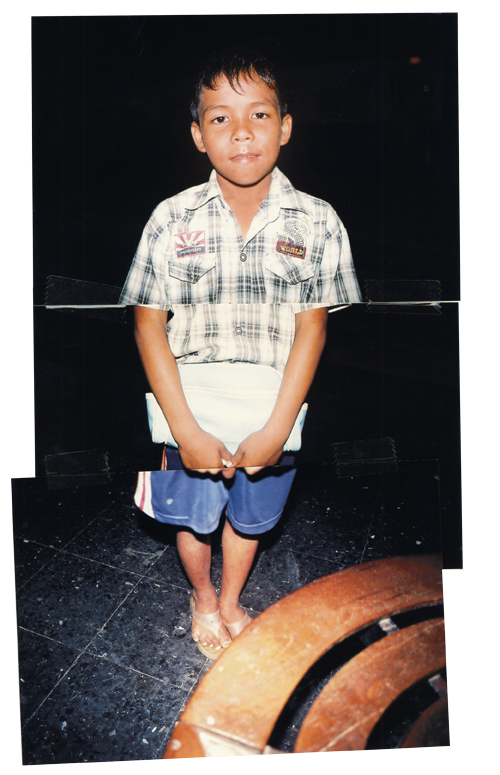
“All I want for my birthday is for my whole family to be together.”
—Gop, 8
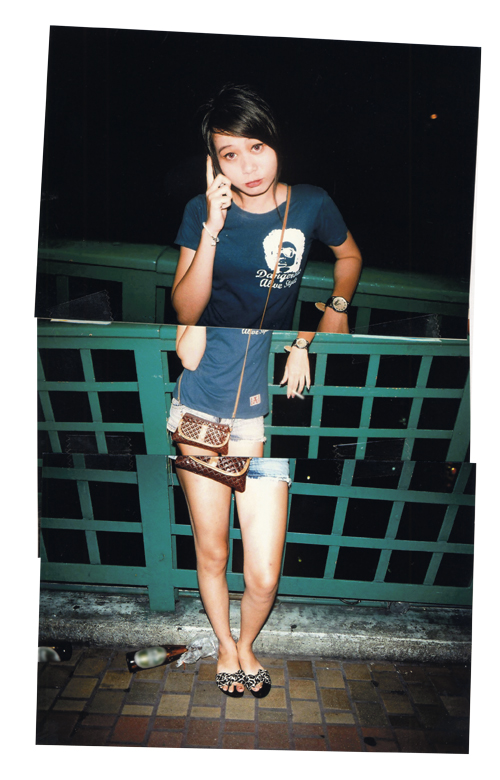
Prieow (19) loves the thrill of speeding on her boyfriend’s motorcycle.
“I love hanging out where there’s fast bikes, and people racing each other.”
—Prieow, 19
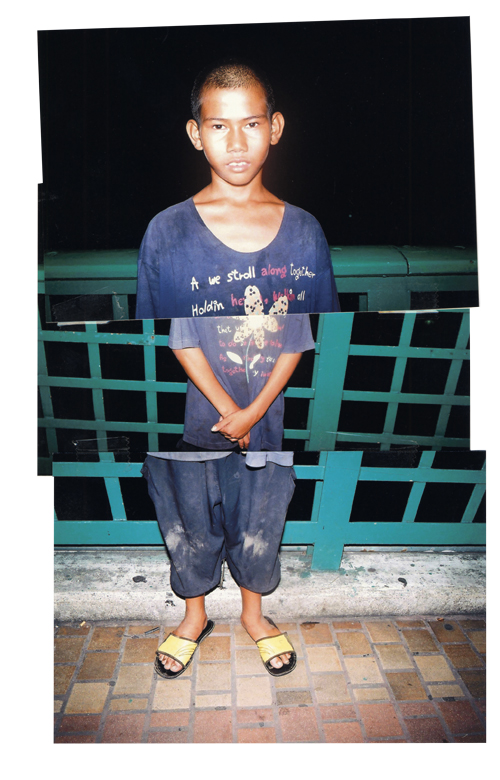
Nu (14) was abandoned by his family.
“I spend most of my nights begging for change. It’s ok, sometimes it’s even fun.”
—Nu, 14
57%
Street children who listed begging as their occupation.
4%
Street children who are sex workers.
18%
Street children who say they live on the streets to make money for their families.
15%
Street children who said they have been victims of sexual abuse.
88%
Street children who have spent more than a year on the streets.
34%
Street children who have spent more than three years on the streets.
87%
Street children who have stoppedattending school.
9%
Street children who have never been to school.
 Goy-Ty (16) hasn’t seen her parents for a while.
Goy-Ty (16) hasn’t seen her parents for a while.
“The good days have passed already. It seems like every day is just tough lately.”—Goy-Ty, 16
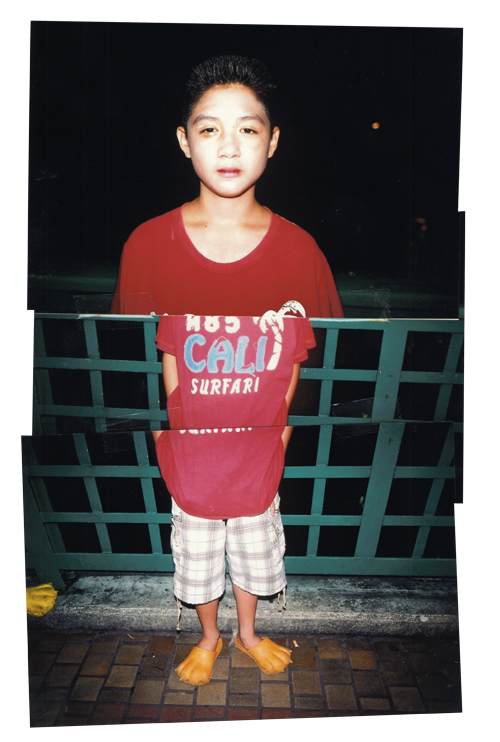
14-year-old Pete’s greatest fear is girls.
“We got in [to a pub] by giving the bouncer B90.”—Pete, 14
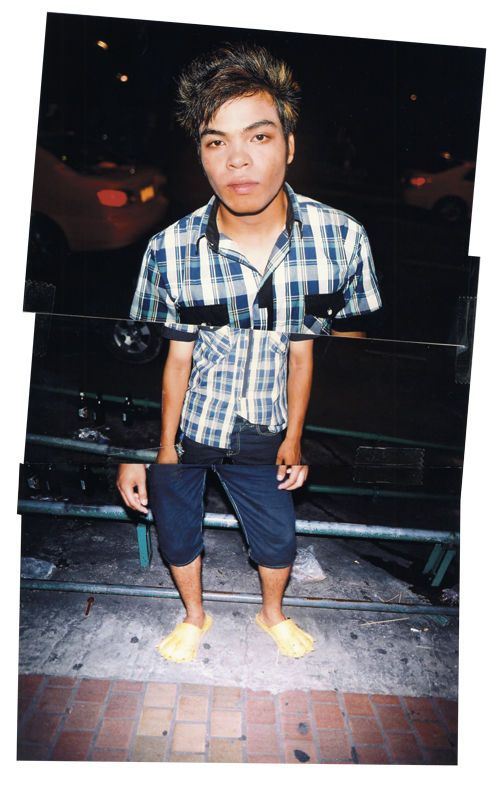
Daeng (20) is coping with heartbreak by hanging out at Saphan Phut.
“The best day of my life was when I was with my girlfriend. The worst day was when she dumped me, yesterday.”—Daeng, 20
At this point, the crowd of teens are becoming increasingly intrigued by what we are doing. They urge Goy-Ty (16), who is constantly adjusting her makeup and clothing, to do an interview with us. For someone so young she seems pretty world weary, as she announces that she’s given up on school. “The good days have passed already,” she says, laughing. “It seems like every day is just tough lately.”
Still, unlike some, she’s still in contact with her parents, even if she only goes to see them when she needs money. It’s money she uses to pursue her favorite pastime. “I love going to pubs,” she says, cheering up a little bit. “My favorite is the Regent.”
We leave Goy-Ty but quickly run into 14-year-old Pete, who is busy making stabbing motions and pointing to our cameras. Like Goy-Ty, he likes to hang out at pubs and remembers his first time drinking there as the best day of his life.
“I went to the pub at a full moon party,” he says, chin raised trying not to break eye contact. “It was super fun. We got in by giving the bouncers B90 and got really drunk.”
Pete might be only 14 but he’s also had to deal with the more violent aspects of life out on the streets. “I was chasing some guys and they started chasing me back with a knife,” he says with a cocky smile as he recalls the day he almost got stabbed. Still, despite the tough man exterior, there’s also a hint of the child he still is as he tells us his biggest fear: “Girls!” he blurts out before disappearing for more beer.
We sense the kids are tiring of our presence and want to be left alone to their vices because they start to inch away from us. Pete comes back with a couple more beers and they fill up their glasses. It’s around 1am and they’ll probably do the same thing tomorrow and the day after. As they refuse to talk further, we decide to pack it in for the night to go back to the comfort of our beds—not a choice many of these kids have.
Chardchakaj Waikawee, 29, used to take photos of models for a living but decided to focus on a very different subject in his exhibition, Youth, about disenfranchised kids in Bangkok. We asked him why he swapped the glamor of the catwalk for seedy sois and what inspires him to document these children.
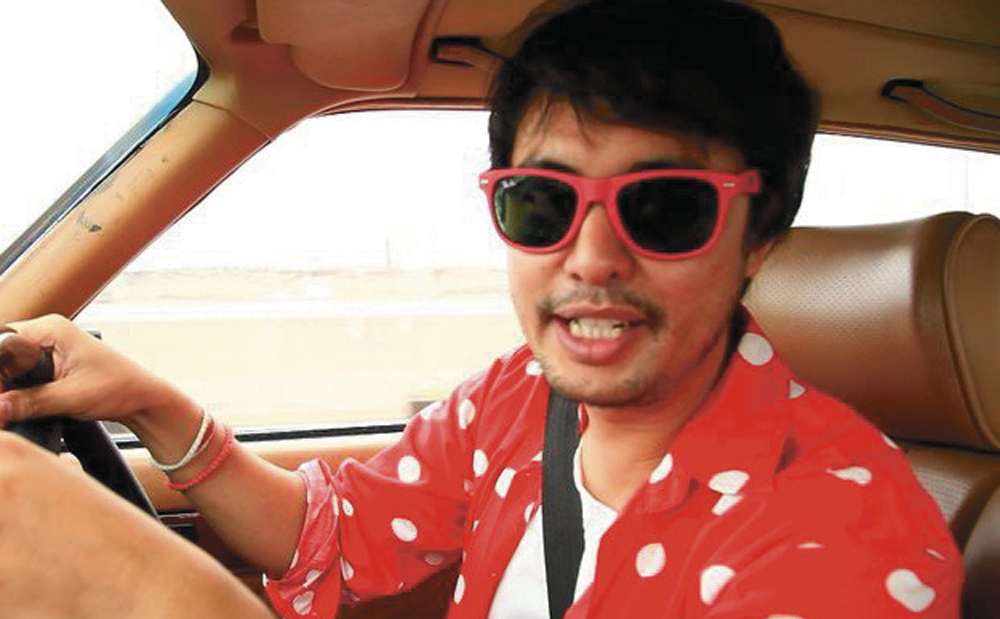 Why did you decide to make the switch from fashion to documentary photography?
Why did you decide to make the switch from fashion to documentary photography?
It’s boring taking photos of people my age. They’re always trying to act, trying to be cool. But taking these documentary style photos is very pure. My subjects don’t pose. They’re just themselves.
What sort of feedback did you receive about your exhibition?
I was flipping through the guest book from the opening night of the exhibition and someone had written, “We need people like you to keep social issues alive.” That was really inspiring.
Why focus on projects about youth culture?
I think it’s fun to observe and examine a new way of life, and study a new culture that’s always overlooked. You can see how politics actually shapes culture if you take the time to look.
So you think there’s a political aspect to your images?
Everyone’s so crazy about politics, but politics are right in front of our own eyes. I don’t want to tell people that my photos are political because I think a portrait of a child left on the streets is strong and already loaded with meaning. I’m just trying to remind people that they should just open their eyes a little bit.
Do you think your photos can make a difference?
I don’t think my photos are art. They’re more like recording and communicating feelings. I hope that my work is more than just photos. Interview by Clae Sea
For over twenty years Sitthiporn Thumnieam-ngarm has been part of the non-profit organization Baan Somdej, devoting his life to teaching street kids.
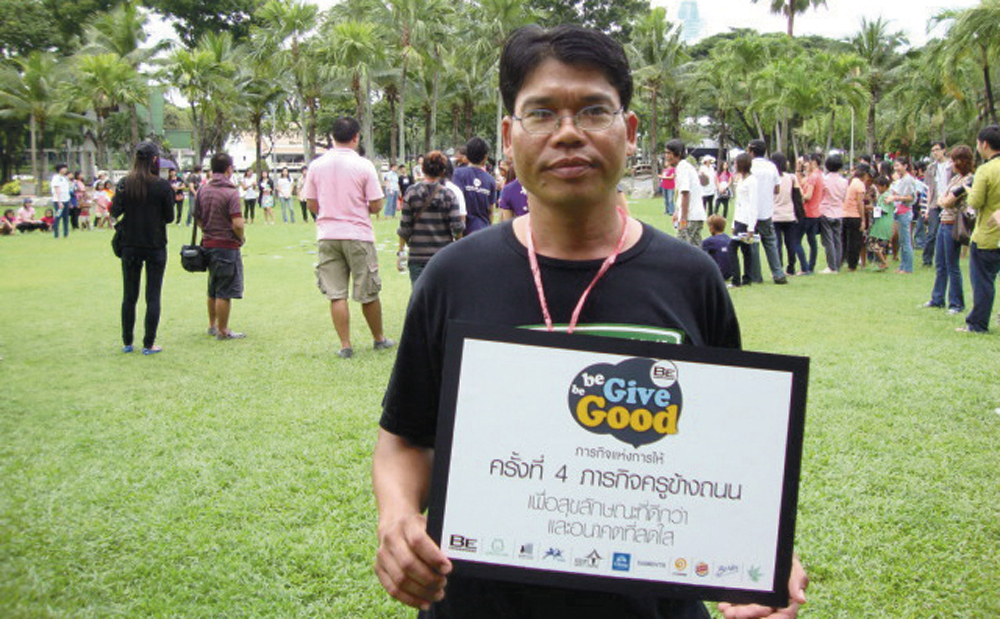 How did you start out working with the kids?
How did you start out working with the kids?
I studied at Ramkhamhaeng University and while there I helped out at camps in the rural provinces and border areas. I saw a lot of things I wanted to change. The camps changed my perspective. Then in 1989 I moved back home to Pathum Thani, just when the Baan Somdej foundation started the second generation of child care projects.
How do you get through to the kids?
I take them to the zoo, give them crayons and teach them to draw. It’s mostly recreational stuff we do. I just want them to not be afraid because the main goal is to have them stay at a proper residence. They need to trust us first and the method varies depending on each case. Most of the time, the kids aged up to 12 are easier to get through to. The hardest ones are those between 17-22 because they’re already hardened by the street lifestyle.
So how and when do you find them?
I am out all the time, but when depends on the area. The street kids in Hua Lampong are around during late afternoon until early evening. For the Rangsit kids, we’ll mostly see them in the early morning, between 6am-8am.
What are some difficulties you face?
Some of the kids we see in the street have been kidnapped. It’s difficult to tell the difference between those kids that have left abusive homes and those that have been forcibly taken by gangs. Dealing with the gangs can be tricky, if I step on their toes. In the past, I could get in trouble with the cops too. If the police see me hanging out with a gang of kids, they can throw me in jail because there’s nothing that says I am working for a street kids organization. It took 15 years for our organization to become widely known.
Does the government do enough for youth in Bangkok?
Our foundation is not the solution to taking care of the streets kids issue. There are two or three ministries that are responsible. But have you ever noticed the kids wiping windshields in the street in Silom Road? And do you see the police just standing there not stopping them? That’s how it is. I think it is strange how they don’t act unless there’s an order from the big guys. Interview by Ubonwan Kerdtongtawee
Surachai Sukkhiawon is the director for the Baan Nok Kamin Foundation, a house for orphans and homeless children.
 Why did you get involved with street kids?
Why did you get involved with street kids?
I was actually an orphan and street kid myself. I was lucky, I had the chance to study at Ramkamhaeng University and I volunteered to teach street kids at the same time. Afterwards I came here to Baan Nok Kamin.
What kind of issues does your charity have to try and tackle?
We get all sorts of problems, whether if it’s to do with the street children’s documents or no permission from parents. So it’s difficult for them to get into school, even get an ID card. We also need to find these kids that no one cares about.
Why do you try and help?
If these kids grow up without anyone caring for them, they’ll turn into bad people and we’ll become their victims. There are kids in society that have problems.
How do you get these kids to trust you?
When I was a street teacher and met these kids, I’d try to give them advice and bring them into the family, which is the family of Baan Nok Kamin. We take care of them, give them education, teach them to be good kids and see the value of themselves—make them feel that they can live in society with dignity.
Where do their problems stem from?
Some kids are from broken families, or their parents have abandoned them. This creates problems in their mind which make them run away from home or make bad decisions. And when they make bad life decisions, they become social outcasts and run into problems with drugs.
How should these problems be fixed?
The government has to give support to nonprofit organizations. We don’t have the authority to be their guardian.
What are they like when they first get here?
Some come in and are angry and selfish because that’s how they’ve survived so far. We try to give them love and make them feel like they are part of a family.
Are you in contact after they’ve left?
Yes, because we’re a family. Some have graduated from university or have started a family or are working and they do come back to visit us. They come to visit the kids or help with work-related matters. Or when they’re going to marry, they need me to support them like a parent as they have no-one. Interview by Sasinipa Wasantapreuk
Advertisement